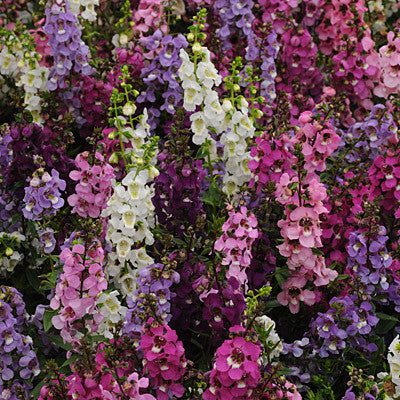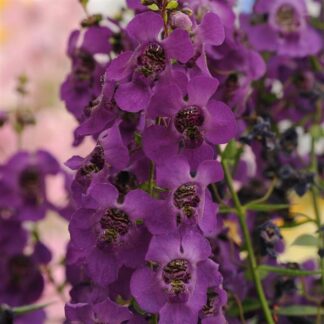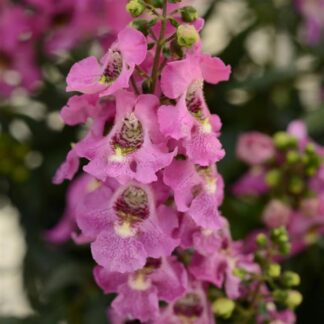Angelonia
Angelonia: The Colorful, Carefree Bloom Machine Your Garden Needs
If you’re on the hunt for a flower that blooms nonstop, stands up to heat, and asks very little in return, Angelonia is calling your name.
Sometimes called “summer snapdragon” (though it isn’t a true snapdragon), Angelonia is a sun-loving annual that blooms from late spring all the way through the first frost. With its upright, spiky flower clusters and lance-shaped leaves, it brings not only vibrant color to your beds and containers but also a whole lot of texture and elegance.
But here’s the best part: it’s easy. Really easy. Whether you’re a seasoned gardener or just beginning your journey into the dirt, Angelonia makes you look like a pro. Let’s dig into everything you need to know—from planting to care to those glorious blooms.
🌞 Why Gardeners Love Angelonia
There’s a reason Angelonia is one of the top picks for summer gardens across the South and beyond. Actually, there are several.
1. Long-Lasting Blooms
Angelonia doesn’t just flower for a week or two. It puts on a continuous show from spring through fall, especially if you give it just a touch of love along the way.
2. Tough as Nails
Hot? Humid? Dry? No problem. Angelonia thrives in the kind of weather that makes other plants sulk.
3. Low Maintenance
No deadheading necessary (unless you want a super-polished look). It’s self-cleaning, meaning the blooms drop off on their own.
4. Pollinator-Friendly
Bees and butterflies love it. You’ll have a buzzing, fluttering garden community in no time.
5. Great in Containers or the Ground
Whether you want to fill a garden bed or perk up a patio pot, Angelonia’s got you covered.

When it comes to planting angelonia, there are a few things to keep in mind. First, choose a location that receives full sun for at least six hours per day. Angelonia does not tolerate shade well, and will quickly become leggy and produce fewer flowers if not given enough sunlight. Next, make sure the soil you select is well-draining. Angelonia does not like wet feet, and will quickly succumb to root rot if the soil is too moist. Finally, consider using a raised bed or container for your angelonia plants. This will help to ensure adequate drainage and prevent waterlogging.
After planting, water your angelonia generously and mulch around the base of the plants to help retain moisture. Angelonia does not require a lot of extra water once established, but will benefit from occasional deep watering during extended periods of dry weather.
Now that your angelonia plants are in the ground, it is time to sit back and enjoy the show! These beautiful flowers will bloom from spring until fall, adding color and life to your garden all season long. To keep your plants looking their best, deadhead spent blooms regularly and fertilize monthly with a balanced fertilizer. With just a little bit of basic care, your angelonia plants will thrive and provide you with years of enjoyment.
Shop for Angelonia Plants and Seeds
Showing all 9 results
-

Angelonia, AngelFlare Black
$8.99 Select options This product has multiple variants. The options may be chosen on the product page -

Angelonia, AngelMist Spreading Berry Sparkler
$8.99 Select options This product has multiple variants. The options may be chosen on the product page -

Angelonia, AngelMist Spreading Dark Purple
$8.99 Select options This product has multiple variants. The options may be chosen on the product page -

Angelonia, AngelMist Spreading Pink
$8.99 Select options This product has multiple variants. The options may be chosen on the product page -

Angelonia, AngelMist Spreading White
$8.99 Select options This product has multiple variants. The options may be chosen on the product page -

Angelonia, Archangel Cherry Red
$8.99 Select options This product has multiple variants. The options may be chosen on the product page -

Angelonia, Archangel Dark Purple
$8.99 Select options This product has multiple variants. The options may be chosen on the product page -

Angelonia, Archangel Pink
$8.99 Select options This product has multiple variants. The options may be chosen on the product page -

Angelonia, Archangel White
$8.99 Select options This product has multiple variants. The options may be chosen on the product page
🌱 Planting Angelonia: Start Strong
Planting Angelonia the right way gives you a head start toward a season of color.
✅ Choose the Right Spot
Angelonia needs full sun—at least 6 hours a day. This is non-negotiable. Without enough sunlight, the plants get leggy and sparse, and their bloom production drops dramatically.
So go ahead and give them the best, sunniest spot you’ve got.
✅ Use Well-Drained Soil
Angelonia does not like soggy roots. Wet feet can lead to root rot, which is a surefire way to lose your plant.
If your native soil is heavy clay or tends to stay wet after a rain, consider:
- Mixing in organic compost and sand to improve drainage
- Planting in a raised bed
- Growing Angelonia in containers, which gives you total control over soil and watering
✅ Spacing
Space plants 8 to 12 inches apart to allow for air circulation and give them room to fill out.
💧 Watering Angelonia: Just Enough, Not Too Much
Water well when you first plant. After that? Angelonia becomes pretty drought-tolerant once it’s established.
Here’s how to manage watering:
- Water deeply but infrequently
- Let the top few inches of soil dry out between waterings
- During hot, dry spells, give your plants a good soaking once a week
Overwatering is the most common mistake. Angelonia likes to be treated a bit tough. In other words, it’s better to underwater than overwater.
🍽️ Feeding for Blooms
For non-stop flowers, your Angelonia will appreciate a little nourishment.
Here’s an easy feeding plan:
- Monthly fertilizing with a balanced flower fertilizer (like 10-10-10 or 20-20-20)
- Or, use a slow-release fertilizer when you plant and top it off mid-season
Container-grown plants may need feeding a little more often, as nutrients wash out faster with frequent watering.
✂️ Pruning and Deadheading: Optional, but Encouraged
One of the reasons we love Angelonia is that it’s self-cleaning. You don’t have to deadhead, but if you want to tidy up your plants or give them a little boost, go ahead and:
- Trim back spent flower spikes
- Shear the plant back lightly in mid-summer to encourage new growth and blooms
This small bit of maintenance can reinvigorate the plant and keep it blooming even more vigorously.
🌼 Angelonia Throughout the Seasons
🌸 Spring
- Plant after the last frost.
- Start with healthy transplants or nursery-grown plugs.
- Water thoroughly at planting time.
☀️ Summer
- Enjoy the bloom explosion!
- Water during dry spells and fertilize monthly.
- Deadhead if desired.
🍂 Fall
- Blooms usually continue until the first hard frost.
- You can compost the spent plants or save seeds (though hybrids won’t always grow true to type).
🪴 Growing Angelonia in Containers
Angelonia makes a stunning “thriller” in container arrangements. Pair it with trailing plants like sweet potato vine or calibrachoa, and fill in with petunias or coleus.
Container tips:
- Use a high-quality potting mix (never garden soil)
- Choose a container with good drainage holes
- Water when the top inch of soil feels dry
- Feed every 2 to 3 weeks with a water-soluble flower fertilizer
Containers may dry out faster than garden beds, especially in full sun, so keep an eye on moisture levels.
🐝 Bonus: Companion Plants and Garden Pairings
Angelonia plays well with others! Try pairing it with:
- Lantana (another heat-lover)
- Verbena
- Zinnias
- Dusty Miller
- Salvia
- Sweet Alyssum
This not only adds color variety but also attracts a wider range of pollinators. The result? A vibrant, lively, and truly joyful garden space.
👩🌾 Troubleshooting Common Angelonia Issues
Angelonia is one of the easiest annuals to grow, but every plant has its quirks. Here’s how to spot and solve the rare problems:
| Problem | What it Looks Like | Solution |
|---|---|---|
| Yellowing leaves | Overwatering or poor drainage | Let soil dry out and check drainage |
| Sparse blooms | Too much shade or not enough nutrients | Move to a sunnier spot and fertilize |
| Leggy growth | Not enough sunlight or pruning | Cut back by 1/3 to encourage fullness |
| Wilting | Could be underwatering—or overwatering | Check soil moisture and adjust |
🌟 Why You Should Grow Angelonia This Season
If you’re tired of flowers that fade after a few weeks or demand too much effort, Angelonia is your answer.
It gives you:
- Color that lasts all season
- Strength in tough climates
- Ease of care
- Beauty that works in any setting
Whether you’re planning a pollinator-friendly paradise, a show-stopping container, or a no-fuss flower border, Angelonia checks every box.
Ready to Add Angelonia to Your Garden?
Let’s make it easy. You can browse our full Angelonia collection, including the ever-popular Serena Mix, right here:
Bring on the bold color. Invite the pollinators. Enjoy the simple pleasure of plants that just bloom and bloom and bloom.
You deserve a garden that shines—all season long.
Want help planning your Angelonia pairings or container combos? Just ask—we’re here to grow with you! 🌿🌸
Showing all 9 results








